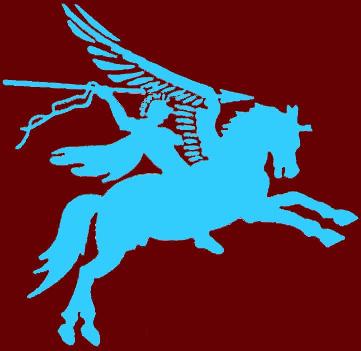
R.A.M.C.
Living History Group
On October 10th 1941 the 31st Independent Brigade was renamed the 1st Airlanding Brigade, and by April 1942 the unit was officially renamed 181 (Airlanding) Field Ambulance, R.A.M.C., having grown from its original size, to a strength of twelve Officers, and 202 O/Rs by January of that year.
Elements of 181 were involved in the Bruneval raid, leaving their base at Chilton Foliat, Berks, to travel to Scotland for specialist training. As 181 were an Airlanding, as opposed to a Parachute, field ambulance they would normally go into action in gliders. On this occasion however, the section of twenty O/Rs, under the command of Lt.Baker, landed on the French coast in landing craft.
On the 15th of May 1943 orders were received for the unit to move to North Africa, and after an 11 day sea voyage they arrived. The next month they joined up with the 1st Parachute Brigade, and preparations began for Operation Husky, the invasion of Sicily.
On the July 9th, the unit departed Tunisia in 6 Waco CG-4 gliders, with the aim of landing in Sicily just after 10pm. The normal glider allotment for a unit the size of 181 was 16 Horsas, so a rapid rethink had taken place to try to fit the men and equipment into the 6 smaller American gliders
All did not go well however, and 5 of the 6 gliders never made the Sicillian coast, having been cast off by their USAAF tug pilots too soon, at anything up to ten miles offshore, and around 25% of the men in the gliders drowned.
181 suffered 24 casualties during the operation, 2 killed, 6 wounded, and 16 missing.
On July 13th the remaining personel left Sicily in an LCT (Landing Craft Tank) and returned to North Africa.
Early in September 1st Airborne Division left Africa for Italy by sea, with 181 soon taking up residence in the Naval Barracks at Taranto and running a General Hospital in the annex at the Rondiella Hospital. This hospital was later handed over to No70 General Hospital RAMC.
During the course of the next two months, sections of the unit moved gradually further north to Foggia, with 74 Officers and men at Putignano, 6 remaining at Taranto, 4 ORs at Foggia, 20 ORs at Altamura, 14 attached to 1st Airlanding Light Regiment, and a further 64 remaining in North Africa.
These sections were reunited in October, before returning to North Africa via Taranto on the 20th of November, and shortly afterwards the whole Division returned home to the UK.
By December 1943 the whole of the 1st Airborne Division was back in the UK, and each unit was allocated a new home base, in towns and villages between Lincoln and Stamford. 181 was sent to Stenigot House, some 7 miles north of Horncastle, Lincolnshire, and Martin, a little village in the Witham Valley, 10 miles south west of Horncastle. At this time the unit had 10 Officers and 104 O/Rs, with a further 1 Officer and 23 O/Rs in reserve.
The entire Division was undergoing re-training, with a view to it being deployed in the North Western European theatre, so the next few months were taken up with additional training and excercises. On March 16th 1944 King George paid a visit to various units in the Division, including 181, where he was shown both the surgical teams and the orderlies at work.
On the 6th of June, 1st Airborne's sister division, the 6th Airborne, was chosen to lead the assault on Occupied France, and although 1st Airborne were briefed for many operations immediately afterwards, it was not until August the 14th that anyone from 181 went overseas, these being the "Seaborne Tail", that part of the unit carrying supplies and equipment to suport the rest of the unit as and when it went into action.
That happened on Sunday, September 17th 1944. As part of Operation Market Garden, 181 flew into Holland in 7 Horsa gliders, landing on LZ "S", a potato field some miles west of Arnhem, at around 1 p.m.
They immediately set up their first dressing station beside the LZ, in some houses beside a road called Duitsekampweg, in Wolfheze.This was to have been a short stay, before moving on to their objective, the Arnhem Municipal Hospital. The dressing station was fully running by 4.30 p.m., and the surgical teams performed their first operation an hour later, with another 7 following that night from the 60-odd casualties admitted.
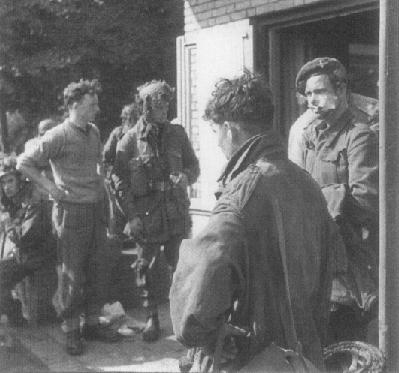
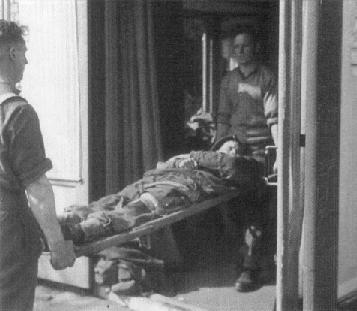
18/9/44

The DS on Deuitskampsweg was in the houses seen in the distance.
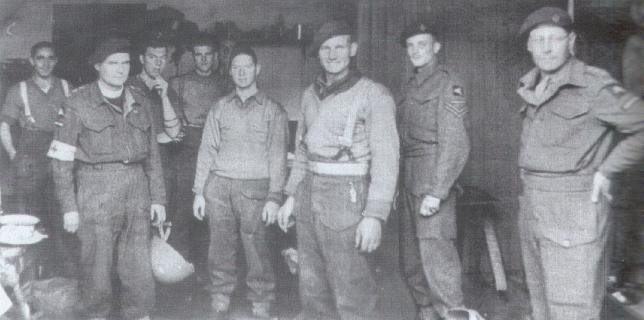
Left to Right: Cpl. G. Aldred. Capt. Rev. B. Benson. (Padre) Pvt. S. Archer. Pvt. G. Williams. Pvt. P. Jackson. Pvt S. Biggs. L/Cpl. F. Budd. Cpl. K. Hollingsworth. Capt. M. James. (Surgeon)
Later that day it was decided to concentrate all the remaining personnel of 1st Airborne Division nearer the Divisional HQ, which was by then in the Hartenstein Hotel in Oosterbeek, a few miles nearer Arnhem than Wolfheze. (This building is now the Airborne Museum)
Leaving the reserve section at Wolfheze, 181 packed up and moved along the previous days line of advance.
After some searching, it was decided that the most suitable building in Oosterbeek was the Schoonoord Hotel, on the south-west side of the Utrechtsweg-Stationsweg crossroads, a few hundred yards east of Div. HQ. This decision was taken purely as a temporary measure, while waiting for the advance to Arnhem to restart, as it was clearly stated in the RAMC manual of the time that an MDS (Main Dressing Station) should NEVER be sited on a crossroads. Among the reasons for this, is that artillery is often targetted on crossroads and the like to disrupt movement.
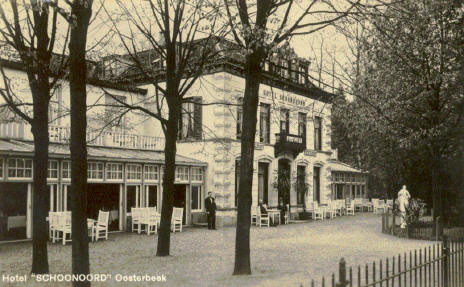
Above: From a pre-war postcard.
Below: The ruined building in 1945.
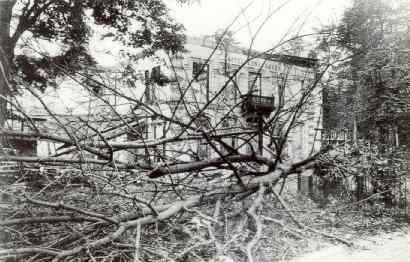
To be continued.
In the meantime I have posted up Major Frazer's report, which covers 17th September 1944 to 13th April 1945, when he was released from a POW camp.
Also, I have posted Pvt. D. Bartrum's account of his time during the battle here.